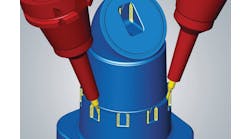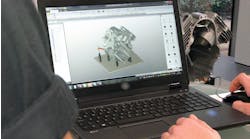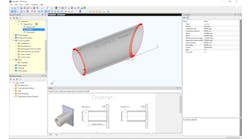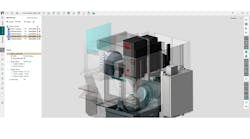Industry leaders anticipate and prepare for the changing face of manufacturing software.
Technology is the most influential business sector changing the shape of the economy and everyday life in the 21st century. Its reach extends far into the manufacturing world, and, in the last four decades, technology has made its irreversible mark with NC, DNC, CNC, CAM, and CAD.
Now the industry is wondering where manufacturing technology, and specifically CAD/CAM technology, is headed in the future. To help answer that question, AMERICAN MACHINIST Editor Tom Grasson and Publisher Joe Fristik assembled eleven top manufacturing-software executives and asked them pertinent questions about industry growth, challenges, trends, and wisdom. Industry leaders noted similar concerns, but had varying solutions about how to approach new trends and satisfy the increasing needs of customers.
Gary Fulton
President, Teksoft
Fulton: I think we will see continued growth because there is a lot of change occurring especially in the manufacturing industry. There are a lot of new inexpensive 4, 5, and C-axis machines coming to market. These machines require new generation CAM systems. There are always changes to operating systems and right now there is a huge trend towards solids. About 80% of our sales currently involve some sort of solids machining. As long as there is change, and I think there will continue to be lots of change, end users will need next generation CAM products to stay competitive.
We’ve witnessed tremendous sales growth in CAD/CAM over the past several years. Are we likely to see the same type of growth continue in the next one to five years, and, if so, in what areas? Also should we expect the same rate of growth for both the CAD and CAM industries?
Noland Chhun
Regional Sales Manager, SolidWorks Corp.
Chhun: I anticipate that the 3D CAD market will continue to grow significantly over the next few years. Every day, more companies are making the transition from 2D to 3D CAD software. We live in a 3D world, but engineers still tend to rely on outdated 2D design software. Because so many companies still need to make the transition to 3D, growth in the CAD market will be tremendous. In regards to your last question, I am not an expert in the CAM industry, but I anticipate that the CAM market will also continue to grow significantly.
Chuck Mathews
V.P.Marketing, DP Technology Corp.
Mathews: Looking at CAD/CAM in the context of declining machine tool sales in recent years, the expectation is low, single digit growth from the CAM market. But I think the CAM market is stalled. It's waiting for a revolutionary change. There needs to be a significant increase in the value proposition that the CAM vendor delivers to the consumer in order to get the market fired up again.
There are, however, significant opportunities for CAM vendors. There are a lot of low-cost, 5-axis milling machines coming out. And, in general, there are a larger number of multifunctional turning machines being sold. That leaves an under served section of the CAM market, because there are not many good solutions available to those consumers. So in that section, I believe there is significant growth potential beyond single digits.
Steve Sivitter
CEO, PathTrace
Sivitter: If a company has a better technology in a certain area, it will probably see significant growth through market-share transfer. Also, I've been somewhat surprised by the amount of 2D software that still needs up-grading out there. The 2D world can still drive a lot of business for the CAM guys.
CAD products can also drive a lot of CAM business. There will surely be another leap in CAD technology in three, four, or five years — which will help our business.
The final area, I think, is global growth. Last week, I visited a Central American company that had already been seen by two of my competitors that same week. It was a country where we probably wouldn't have looked for business five years ago. So, clearly, we're all competing in corners of the globe where we haven't before, and these areas still have vast potential.
Dan Marinac
V.P. Marketing, Cimatron Technologies
Marinac: Cimatron is a fully integrated CAD/CAM system committed to providing the mold, tool and die industry with comprehensive, cost-effective solutions that streamline manufacturing cycles, enable collaboration with outside vendors between users, and ultimately shorten product delivery times. In North America, we're likely to experience single digit growth this year due to the economic downturn — especially in the automotive industry, however we are much more optimistic about double-digit growth in the next 5 years. We don't know of a mold/die shop that doesn't have a CAD or CAM system of some kind. Even so, there is room for growth based on the pressure from suppliers who demand high quality tools in shorter lead times. Implementing new technology will enable moldmakers to compress the mold delivery cycle, elevate critical design variables early in the process, and eliminate repetitive manual tasks. The vision of predictive manufacturing and process automation in the mold, tool, and die business ensures a great demand now and in the future. But then we look out-side of the U.S., and we see these vast countries waiting and starved for technology. Some are still making molds as we would have done 10 years ago, and they are eager for this technology. They're getting the information of the technologies available via the Internet, and they're anxious to compete globally for mold, tool, and die business.
William Gibbs
President & CEO, Gibbs & Associates
Gibbs: There are three distinct groups at this table. Two-thirds of us are standalone CAM or CAM specialists. Then we have some of the giants in our industry whose big business has always been the integrated solution. And then there is the CAD-focused group. My comments are only directed towards the PC CAM-focused market. I see that market maturing. Ten years ago, if you could cut a contour and do a pocket, you were a decent product. Today, we're all running around trying to teach our customers about feature number #5000 and feature #5001. But the list of things that are important to a customer is getting smaller as they try to distinguish what's important to them. So the opportunity for us to achieve significant growth starts to diminish.
Our company sees good growth potential in targeting niche markets with specialty products. Likewise, we have opportunities in market areas that haven't been addressed, like Central America. Other than geographical opportunities and niche opportunities, the overall market is not the wide-open plain it once was. I think a lot of our market is going to be driven by forces besides features in the future. I think we're going to have to become more sensitive to quality issues, quality of product issues, customer support issues, and customer service issues. We're going to have to pay more attention to providing a complete solution because all the customer really wants is to be satisfied. He doesn't care how many features he gets as long as he receives a solution to his problems.
Bryan Diehl
Vice President, Surfware Inc.
Diehl: New sales growth is being driven by companies that already have CAD and CAM products and are looking for one more little piece. More and more companies now have multiple CAM and CAD products. This makes interoperability of the data incredibly important. Some of the older-style formats can go by the wayside, but interoperability for ease-ofuse is a must when selling to these clients.
What are the biggest challenges facing the CAD/CAM industry today?Andreas Saar
Director of eFactory, Unigraphics Solutions
Saar: For us, the biggest challenge is opening our company's direction beyond the CAD/CAM industry focus and becoming a global supplier by broadening our technology bandwidth. This means, we will provide our customers with solutions for full product life cycle support — from product design through manufacturing planning to order fulfillment. This goes beyond the traditional mechanical CAD/CAM spectrum on products. I think one of the major challenges here will be the utilization of new technologies like the Inter-net or modern collaboration tools and their productive usage in the manufacturing industry.
Another major issue is certainly interoperability, which is one of our three platform strategies. We think companies have to be able to exchange information quickly and easily to be really productive.
Mark Summers
Vice President, CNC Software Inc.
Summers: I would say one of the biggest challenges is creating and maintaining a product that has great depth and interoperability. I think we CAM developers all want to have a solution that works well for all types of machine tools, but the likelihood is that we will continue to have our strong points and our weak points. This means some of our customers will continue to use more than one CAD/CAM product, and those products need to communicate with each other. Being able to translate all of the data to and from all CAD/CAM systems is a challenge.
Sivitter: One of the problems our industry faces is one of credibility. I think in certain quarters there is a degree of overselling. Some potential customers are not going to believe anything you tell them because they've heard false promises before.
Acquisitions also play into the credibility issue. Many customers are wondering whether their vendor or system will be around next year. We've seen a number of good products and technologies disappear due to acquisition, and I doubt we've seen the end of it.
Gibbs: Generally speaking, there are challenges to our industry about bringing about interoperability in a reliable manner. So many of these things are interrelated. When a system can't communicate, the customer doesn't care if it's a bad CAD file or a bad CAM system. He doesn't care about the issues at all. His immediate reaction is: "I've just been burned." So it goes into a quality and a credibility issue. So we have to get past the technical issues of how to make interoperability work and how to move data between things. These are technical issues that we are all most comfortable with because they are all quantifiable — we can stick them on a piece of paper, we can identify what needs to be done, and we can analyze everything to death. But then it comes back around to issues that involve usability. And again this overlaps the fundamental quality of products. There are so many people who've been burned and how do you get someone to embrace change when the last person they found that embraced change got all their fingers burned off. I would second the point that we all have the responsibility to follow through with what we sell and make it a reality for the customer.
Mathews: There are three big challenges. The first being the concept of the whole product. CAM guys are notoriously focused in on feature one, feature two, and feature three. The customers really need a whole product with quality technical support, good quality documentation, and on-time delivery. CAM companies need to ask if their training course is delivering what it needs to deliver, if their documentation is delivering what it needs to deliver, and if their sales people are properly educated.
In terms of where the value is for the future, it's about knowledge automation — improving CAM software productivity by imbedding knowledge into it. Making it so there is less data input needed to actually program the machine. And finally there is interoperability. This is a huge issue for all of us. The better the job we can do on CAD/CAM data exchange, the farther we can progress with knowledge automation.
Is it reasonable to expect some consolidation or perhaps fallout within the CAD/CAM industry within the next five years?
Marinac: History is the best teacher. The CAD industry has historically led the implementation of new technology (paradigm shift) versus CAM by about five years. This is not only true of technology, but also in business consolidation. It was only five years ago that we saw the CAD industry aggressively acquire the mid-range players, such as Computervision, Applicon, and Camax. Now, on the CAM side, we're facing that same pattern.
We can expect CAM-oriented companies to be merged and consolidated as the larger players move away from the idea of providing complete CAD/CAM solutions (due to the cost of maintaining and producing these types of products) and towards complete life cycle management and enterprise-wide product data management.
Saar: There are three basic reasons why companies acquire others: to obtain missing technology, to gain people with expertise, and to increase the customer base. Merging products is in most cases difficult or impossible. So normally you have choose one over the other. So people and customers are the most important reasons, but also the most difficult to deal with.
So you have to make sure that the acquisition is economically and politically appropriate. We expect further consolidation in the CAD/CAM industry.
Summers: It's hard to predict the future of other companies, however, acquiring a CAM company appears to be a difficult process if another CAM company is doing the acquiring. Do you convert all customers to one product or maintain both products? What's the best solution? Depending on the plan this could drastically change the value of what they are getting. Is it the technology or the customer base? My guess is there will be just a very few acquisitions or fallouts in the next few years.
Sivitter: This is certainly one of the greatest fears of our customers. There are two areas of the marketplace: the high-end, large, integrated CAD/CAM vendors and the PC-based CAM market. In the high-end CAD/CAM area, we've just seen further consolidation, and it would be unwise to suggest there won't be further mergers or acquisitions.
The PC-based CAM vendors tend to be companies owned by one or two people. Often when a person starts a business and remortgages his house or sells his favorite car to get the company going, the actual valuation he then puts on that business is not based upon accounting practice but emotion. This makes consolidation more of a challenge. Saying all that, I think you will see some further consolidation.
What effect is the web having on design and manufacturing software? Will it have a major influence on major software developments?
Peter Lord
Director of Technology Sales, PTC
Lord: There are two things about the web. One is that it is a telephone on steroids, so it really does allow better communication from vendor to supplier or from software provider to customer. The other context is user interface — trying to improve user experience. Web based user interfaces are so intuitive that we need to think about how we will imbed that browser look and feel into our software development. That's the next challenge. If we can do that, then all the concerns about changing software tools are removed and customers use your product because it makes the work fun.
Tom McCollough
V.P. Software Development, EGS
McCollough: What the web has given us are the killer apps of e-mail and the browser. I think the next great leap is going to involve high-speed, always-on connections. The combination of high-speed and always-on connections fundamentally changes the way that the Internet is used. As more and more of our customers come online with these types of connections, it will enhance the relationship that we are able to have with them. The primary benefits will be better customer support and better running software due to the ease of upgrades. Most of our customers don't have these connections right now, but I think it's coming.
Fulton: The web is a nice tool that can be used to provide product information to potential new customers, to distribute software updates, and to support customers. I do not, however, see much CAM software being sold over the web in the near future. CAM software is quite complex and end users need that local distributor to drive across town to do customization, help with problem parts, and help solve problems.
Mathews: I look at the Internet as an essential part of any business equation. It's that straightforward. Today, most of us are using the Inter-net for software distribution and technical support. Going forward, the web will serve as a tool to provide content to the end user and facilitate data exchange. It will provide collaboration between groups of people and offer us alternative forms of software licensing.
What percent of manufacturers would you estimate using CAD/CAM today? Do you see it as becoming a mandatory means of conducting business in the future?
Chhun: I would estimate that about 40% of manufacturers are using 3D CAD today, but that number increases significantly every day and will continue to grow as more companies adopt 3D design software practices. That answers the next question, which is, yes, it is mandatory for companies to use 3D CAD in order to become successful and remain ahead of the competition. 3D CAD enables companies to reduce design time, lower production costs, make fewer design errors, and get to market faster.
Diehl: I would guess 75% to 80% of manufacturers of all sizes are using CAD/CAM. Most have CNC machines, but some don't; obviously, those with CNC are more likely to have CAD/CAM systems. There are still many low-tech businesses out there that don't have CAD/CAM now but will need it soon. I believe it will be a requirement in the near future.
Saar: To answer this question you have to look into the different market zones because you'll get different numbers for North America, Europe, and Asia. We believe in North America the percentage is 70% to 80%, but I wouldn't put this number on the table for Europe. Europe is probably more towards 50% or lower. In Asia, even though there is a lot of mold business there, it is very difficult to say. In addition the penetration depends heavily on the market focus. We traditionally serve the automotive and aerospace market, where CAD/CAM is mandatory. Europe is more machinery oriented and a lot of work is still 2D and NC is done at the controller level. But I would say yes, it's mandatory for the future.
Lord: It feels like there are really two classes of customers. The first, the mold, tool, and die guys, are using CAD/CAM tools 100% because the geometry is so sophisticated and the shapes so difficult to describe in any other way but CAD/CAM. We don't see the same level of adoption in the other area — the production world of the large OEMs and the jobshops. Primarily, that is because of the machine technology and the production of similar forms. So here the adoption rate is much lower, less than 50% in many cases. We think there's opportunity to put CAD/CAM in these areas, but we have to make it as easy to adopt as the current systems that exist. The other thing that's happening is that there are a lot of CAD/CAM operators with expertise who are leaving. So now there's a tremendous requirement to give our customers tools so they can capture the knowledge of those senior resources and make them available to new employees.
McCollough: For different applications you're going to see different rates of acceptance for CAD/CAM. Turning is going to be less due to the simplicity of many turning applications. But about 80% of CNC users are using some form of CAD/CAM. Yes, I think it's a mandatory part of the business if you want to make money. Those who aren't using it are going to start.
What effect might the apparent trend in increased outsourcing have on design and manufacturing software?
Marinac: There are two key points that arise from outsourcing: Data Translation and Engineering Changes. This entire trend has led us to making Data Translations a paramount requirement. We've spent a lot of time working on direct or native data translation in addition to relying on industry standards such as STEP, IGES, and VDA. We've completely redesigned the front end of our software to seamlessly manage CAD surface and/or solid imported data. We are designing it as a welcome starting point for the mold, tool, and die design and manufacturing process and, as such, it will accommodate the Engineering Change process. That's really the focus of the rebirth of our Elite product. Once in production, the real challenge will be in dealing with 'poor data' up-front and yet still allowing parametric and associative hybrid design, for implementing ECOs, on the back-end for mold design and manufacturing.
Saar: The major issue companies have to deal with in terms of increased outsourcing is incompatible information/data and access. Therefore, data interoperability and supplier collaboration are the major issues. Data standards and common visualization tools as well as modern Inter-net enabled collaboration techniques will become highly important. Companies will request that data are shared and products are integrated without going through major hurdles. Despite standards like STEP, XML, etc. we haven't reached this point yet.
How is your relationship with machine tool builders changing?
Mathews: I think the builders are really our most important customers. They are our partners and customers in the sales process. To them, we are somewhat of a necessary evil because their systems and their sales people need the software to demonstrate the machine capabilities. As they introduce these more sophisticated high-speed machines like 5-axis mills and multifunction, multi-axis lathes, they will need CAD/CAM even more. Every successful machine tool builder is going to have a CAD/CAM partner.
Marinac: When we see the new individual technological innovations in machining technology such as spindle rigidity, cutting tool materials and laminates, toolholder dynamics, and smart NC controls, we really only see them all come together for public consumption at the machine tool vendor's site. And that's when they have to prove that all this new technology really works. And typically, that's when we're called in. Machine tool vendors are dependent on sophisticated CAM programs to best demonstrate their machinery. It follows then that all of this new machine tool technology has had a major impact on the development of our toolpath strategies. We had to react quickly to implement the new toolpath strategies and techniques. The result has been the establishment of Cimatron -- the leader in high speed machining and in implementing 5-axis toolpath strategies focused on the special needs the mold, tool, and die industry. But we are always looking ahead to see what the next new development will be.
What words of wisdom and/or cautions could you give shops that are selecting design and manufacturing software?
Fulton: Do all the research you can, educate yourself, visit the developers' websites, get demos, and benchmark those demos. Have the software do your parts. Talk to end users who are doing similar-type products. Make price an issue but not the main issue. And make sure you can get lots of local support, and don't skimp on training. Get lots of training.
Chhun: Do your homework, ask a lot of questions, and ask for customer references. And then, when you speak to the customer references, make sure that you ask about their needs. How are their needs different than your needs? Why did they make the decision to purchase a specific software package? And most importantly, make sure you can get local technical support and interview the local support team. It's also important to make sure that the software has a short learning curve and a significant number of add-on products to assist with your additional engineering and design needs.
Diehl: Customers need to know how to better evaluate products. When they are getting a standard demo from a CAD/CAM salesperson, they should bring in their real parts to see how the system works with what they're actually going to do in a real day. Every product has different strengths and weaknesses, and the demo jock can show features they don't need. Customers need a system that works well with their real needs.
McCollough: My words of advice would be, "Be prepared to work hard." Turn over all the stones in the software as it relates to your particular application.
But stick to what you know — evaluate the software only with respect to the applications you know you'll be using it for. Don't try to anticipate too far in the future; you'll probably get it wrong.
Gibbs: Every customer should focus on what they do, what they need to do, and who the user/programmer is going to be. They should evaluate products against those givens/needs. This approach is so uncommon that it is rarely encountered. Everybody wants to go out and objectively evaluate CAM products, but they end up evaluating products based on who has the best demo jock. Now, we all have good demo jocks. That doesn't prove much. And customers all want to go out and look at parts of ultimate complexity even though they never are going to see a part of ultimate complexity. So if a customer, who does nothing but 2-axis milling, goes out and picks the system that he was most impressed with because of its 5-axis simulations, even though they do nothing but 2-axis milling, they've probably made the wrong decision. People really need to focus on the simpler things like their own company's real needs and circumstances when buying a CAM system.
Summers: First I'd like to acknowledge that evaluating a CAD/CAM system for a shop is a difficult thing to do because it's a complex job with lots of features and options that need to be explored. Most importantly, make sure the system you end up with will handle the parts that make up the majority of your business. Look at the CAM vendor's track record, installed base, and make sure you can upgrade your software to handle more complex applications down the road and/or support other machine tool types that may be purchased in the future. Make sure the support behind the product is strong.
Lord: Consider why you're buying CAM software. Most manufacturers want to innovate processes, make themselves better, or make a profit with the machine. If that's the case, then what you're buying in your CAM software is business-critical software. You want to en-sure that the personal side is strong. Is the support going to be stable, and is it going to be available to you? In addition, customers expect to grow their businesses and to acquire new capital equipment. They need to buy software that can grow as they change capital equipment. That can adapt to that new technology. And then, beyond simple tool-path generation, look to how you will use the data that's generated. What kind of deliverables do you need to make and what kind of information do you have to share upstream with customers and downstream to the execution system? You want a system that simplifies the operation and usage of generated data.
Sivitter: Choosing a CAD/CAM system is a tough decision. Many customers evaluate software on the worst jobs that have gone through their shops. These aren't really representative of what the shops do on a daily basis. So I suggest they benchmark a part they do every day. Also, the relation-ship with the reseller does matter. A good vendor or reseller offering good support can make up a perceived 20% deficiency in a product any day of the week.





